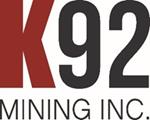VANCOUVER, British Columbia, Dec. 05, 2023 (GLOBE NEWSWIRE) -- K92 Mining Inc. (“K92” or the “Company”) (TSX: KNT; OTCQB: KNTNF) is pleased to announce results from the updated resource estimate completed on the Kora and Judd deposits, at its producing Kainantu Gold Mine in Papua New Guinea. The resource estimate is based on surface and underground exploration diamond drilling and underground face sampling. The focus of exploration at Kora and Judd since the previous resource estimates (previous effective date of October 31, 2021 for Kora and December 31, 2021 for Judd) has been predominantly on resource growth.
Kora and Judd Deposit Mineral Resource Estimate Highlights
- Kora Measured and Indicated Resource of 2.3 million ounces at 10.24 g/t gold equivalent (“AuEq”)(1), representing an +8% increase from the previous resource estimate of 2.1 million ounces in October 2021.
- Kora Inferred Resource has increased substantially to 3.9 million ounces at 8.60 g/t AuEq, representing a +58% increase from the previous resource estimate of 2.5 million ounces in October 2021. This has resulted primarily from successful drilling of the southern extensions of the K1 and K2 lodes.
- Judd Measured and Indicated Resource of 0.35 million ounces at 8.68 g/t AuEq(1), representing an increase of +167% from the previous resource estimate of 0.13 million ounces in December 2021.
- Judd Inferred Resource of 0.56 million ounces at 7.72 g/t AuEq, representing a +211% increase from the previous resource estimate of 0.18 million ounces in December 2021. The increase in the Judd resource has been the result of a significant amount of drilling since the last resource, with drill defined strike length extended +130% since the end of 2021.
- Significant component of the updated Kora and Judd Mineral Resource are high grade (see Fig 3, 4, 7 and 8).
- Excellent reconciliation between mill feed and the updated resource model with a 1% difference in gold ounces. Depletion from the previous resource based on production was approximately 900 kt at 10.4 g/t AuEq (7.9 g/t Au, 0.68% Cu, 12 g/t Ag) or 300 koz AuEq contained metal(2).
Resource Growth Opportunities and Exploration Targets
- Significant expansion potential at both the Kora and Judd vein systems. The Kora vein system is open along strike and at depth, with exploration focused on Kora, Kora South and Kora Deeps target areas. The Judd vein system is open in all directions, with drilling focused on Judd, Judd South and Judd Deeps target areas. Drilling plans to commence at Kora South Deeps and Judd South Deeps in 2024 (see Fig 10 and 11).
- In addition to the Kora and Judd vein systems, there are multiple near-mine high-priority exploration areas including: Arakompa, Maniape and Karempe. Drilling at Arakompa is planned to commence in late-2023 / Q1 2024 (see Fig 12).
- Multiple highly prospective porphyry targets also being explored, with drilling at the A1 Porphyry target underway. The Blue Lake Porphyry deposit which hosts a 10.8 million ounces AuEq / 4.7 billion pounds inferred resource (see August 9, 2022 press release) is open at depth and the Company plans to follow-up with a third, deeper program.
- Currently up to 11 drill rigs operating and in October 2023, K92 increased its exploration budget to a record of US$20 million.
Note (1): Cut-Off of 3 g/t gold equivalent.
Note (2): Based on production recorded from the beginning of Q4 2021 to the end of Q3 2023.
Table 1 – Global Kora and Judd Mineral Resource (Effective Date September 12, 2023, 3 g/t gold equivalent cut-off)
| Tonnes | Gold | Silver | Copper | AuEq | |||||
| Mt | g/t | moz | g/t | moz | % | kt | g/t | moz | |
| Kora | |||||||||
| Measured | 3.7 | 8.74 | 1.0 | 20.5 | 2.5 | 1.21 | 45.0 | 10.96 | 1.3 |
| Indicated | 3.1 | 6.99 | 0.7 | 21.9 | 2.2 | 1.31 | 41.3 | 9.40 | 1.0 |
| Total M&I | 6.9 | 7.94 | 1.8 | 21.1 | 4.7 | 1.25 | 86.2 | 10.24 | 2.3 |
| Inferred | 14.3 | 5.60 | 2.6 | 28.7 | 13.2 | 1.62 | 231.2 | 8.60 | 3.9 |
| Judd | |||||||||
| Measured | 0.4 | 9.05 | 0.12 | 19.0 | 0.25 | 0.80 | 3.2 | 10.58 | 0.14 |
| Indicated | 0.8 | 6.37 | 0.17 | 15.6 | 0.42 | 0.73 | 6.2 | 7.76 | 0.21 |
| Total M&I | 1.2 | 7.24 | 0.29 | 16.7 | 0.67 | 0.75 | 9.4 | 8.68 | 0.35 |
| Inferred | 2.3 | 6.27 | 0.45 | 15.8 | 1.15 | 0.76 | 17.2 | 7.72 | 0.56 |
| Kora and Judd | |||||||||
| Measured | 4.1 | 8.77 | 1.2 | 20.4 | 2.7 | 1.17 | 48.2 | 10.92 | 1.5 |
| Indicated | 4.0 | 6.86 | 0.9 | 20.6 | 2.6 | 1.19 | 47.4 | 9.05 | 1.2 |
| Total M&I | 8.1 | 7.83 | 2.0 | 20.5 | 5.3 | 1.18 | 95.6 | 10.00 | 2.6 |
| Inferred | 16.5 | 5.69 | 3.0 | 27.0 | 14.3 | 1.50 | 248.3 | 8.48 | 4.5 |
- The Independent and Qualified Person responsible for the Mineral Resource estimate is Simon Tear, P.Geo. of H & S Consultants Pty. Ltd., Sydney, Australia, and the effective date of the estimate is September 12, 2023.
- Mineral Resources are not Mineral Reserves and do not have demonstrated economic viability.
- Geological interpretation has generated a series of narrow, sub-vertical vein structures based on delineated wireframes on 10m, 20m and 25m spaced cross sections. The design of the lode wireframes is based on a combination of logged geology, Au, Cu & Ag assay grades and locally on a nominal minimum mining width of 5.2m, all coupled with geological sense.
- Resources were compiled at 3 g/t gold equivalent cut-off grades for Kora and Judd.
- Density (t/m3) was modelled using Ordinary Kriging on 2,778 sample measurements. Areas within the mineral wireframes where no density grades were interpolated had average default values inserted at appropriate levels.
- Reported tonnage and grade figures are rounded from raw estimates to reflect the order of accuracy of the estimate.
- Minor variations may occur during the addition of rounded numbers.
- Estimations used metric units (metres, tonnes and g/t).
- Gold equivalents are calculated as AuEq = Au g/t + Cu%*1.6481+ Ag g/t*0.0114. Gold price US$1,700/oz; Silver US$22.5/oz; Copper US$4.00/lb. Metal payabilities and recoveries are incorporated into the AuEq formula. Recoveries of 95% for copper and 80% for silver were used.
John Lewins, K92 Chief Executive Officer and Director, stated, “The updated Kora and Judd Resource estimate has significantly exceeded our expectations for both the Measured and Indicated resource and the Inferred resource. The combined Kora and Judd Measured and Indicated resource increased +13%, net of depletion, to 8.1 million tonnes at 10.00 g/t AuEq for 2.6 million ounces AuEq, and the Inferred resource increased +70%, net of depletion, to 16.5 million tonnes at 8.48 g/t AuEq for 4.5 million ounces AuEq. When comparing the updated resource model’s depletion to mill actuals, Kainantu has delivered a gold reconciliation in-line with the updated resource model within 1%.
Importantly, the resource growth was also achieved expeditiously, over a period of less than two years and at discovery cost of less than US$7.5 per ounce gold equivalent. This was driven by the strong continuity of the Kora and Judd vein systems, with almost all holes intersecting the mineralized structure.
Looking ahead, exploration at the Kora and Judd vein systems will remain a major focus, with drilling targeting multiple highly prospective target areas concurrently, including Kora, Kora South, Kora Deeps, Judd, Judd South and Judd Deeps. Kora Deeps and Judd Deeps have only recently commenced drilling from the twin incline, and the initial reported results from this area via Judd underground development in late-Q3 have been very promising, including 4.6 m at 14.89 g/t AuEq and 6.8 m at 11.77 g/t AuEq from channel sampling in an area previously sparsely drilled and interpreted to be waste. Later in 2024, exploration plans to commence at Kora South Deeps and Judd South Deeps, also from the twin incline.
Beyond the Kora and Judd vein systems, there are multiple highly prospective areas for resource growth near mine infrastructure, including Arakompa, Maniape and Karempe. Exploration pad construction at Arakompa, which hosts a historic resource of 800 koz at 9.0 g/t Au, is underway with plans to commence drilling near-term. Porphyry exploration continues to progress, with drilling underway at A1 and plans for follow-up drilling at the Blue Lake Porphyry in the medium term. Blue Lake hosts an Inferred Resource of 10.8 moz AuEq or 4.7 blbs CuEq.
Recently, in October 2023, K92 increased its exploration expenditure guidance to US$20 million. This was driven by our conviction in the geological potential of the Kainantu Project and we look forward to announcing results from multiple target areas near-term in addition to operational announcements as we transform Kainantu into a Tier 1 Mid-Tier producer over the next 18 months with construction of the Stage 3 and 4 Expansions underway.”
Key Assumptions and Parameters
Underground drilling consists of diamond core for a range of core sizes depending on the length of hole and expected ground conditions. Sampling is sawn half core under geological control and generally ranges between 0.5m to 1.0m. Underground face sampling is completed for every fired round and is to industry standard. QAQC data indicated no significant issues with the sampling or the accuracy of the on-site analysis. Current core recovery of the mineral zone is +95%, with initial drilling recoveries around the 90% mark.
Geological logging is consistent and is based on a full set of logging codes covering lithology, alteration, and mineralization. All sampling and analytical work for the mine exploration program is performed by Intertek Testing Services (PNG) LTD, an independent accredited laboratory that is located on site. External check assays for QA/QC purposes are performed at SGS Australia Pty Ltd in Townsville, Queensland, Australia.
The geological interpretation of the vein systems is represented as 3D wireframe solids snapped to a combination of diamond drillhole data and underground face sampling (see Fig 1 and 5). Definition of the wireframes is based on identified gold (and copper and silver) mineralization in drill core nominally at a 0.1-0.2 g/t Au gold cut-off in conjunction with geological control/sense and current mining widths. The Kora Link is a broader zone of more variably continuous mineralization and butts onto both the K1 and K2 lodes in various places. A total of 4 lodes were delineated for the Judd deposit, with a dominant J1 lode and subordinate parallel lodes for J2, J3 and J1W.
The wireframes were used to extract 1-metre ‘best-fit’ composites (minimum of 0.5m) from the drillhole & sampling database for gold, copper and silver. A total of 30,791 composites were used in the grade interpolation, 24,925 for Kora and 5,866 for Judd. A gold top cut of 1000 g/t was applied to K2, a 400 g/t top cut was applied to the Kora Link and a 400 g/t top cut was applied for the Judd composites. A top cut of 300 g/t was applied to the silver composites but no top cuts was applied to the copper composites. Variography was good for the mined areas of K1 and J1 (due to the face sampling) but only moderate to poor for other areas, as would likely be expected for the style of mineralization.
Grade interpolation of the composite data was completed using Ordinary Kriging with a block size of 1m (X direction) by 5m (Y direction) by 5m (Z direction). A larger block size check model for Kora indicated no evidence of over-smoothing of the gold grade with the smaller block size. A check model excluding the face sampling data indicated no significant difference in gold grade for the measured and indicated estimates at Kora.
Density data was modelled using Ordinary Kriging on a total of 2,778 sample measurements for the different lodes. Density values were determined using the weight in air/weight in water method (Archimedes Principle) on single pieces of representative core. Default average density values were applied to the different lodes where there was a lack of modelled data. Average density for the global estimates are 2.77t/m3 for Kora and 2.61t/m3 for Judd.
A three-pass search strategy was used for the grade interpolation. Search ellipse parameters are listed below. 4 search domains with varying ellipsoid orientations were used for both of K1 and K2 with the search ellipse orientations generally reflecting the subtle changes in dip and strike of the vein systems. The much smaller Kora Link Lode required only 2 search domains as did the J1 and J2 lodes at Judd.
Table 2 – Mineral Resource Search Ellipse Pass Specifications
| Pass No | X radius (m) | Y radius (m) | Z radius (m) | Min Data | Min Octants | Max Data |
| 1 | 2 | 25 | 25 | 12 | 4 | 32 |
| 2 | 4 | 50 | 50 | 12 | 4 | 32 |
| 3 | 12 | 125 | 125 | 6 | 2 | 32 |
Allocation of the classification of the Mineral Resources is derived from the search pass numbers produced from the grade interpolation which essentially is a function of the drillhole and face sample data point distribution. Additional considerations were included in the assessment of the classification; in particular, the geological understanding and complexity of the deposit, sample recovery, quality of the QAQC sampling and outcomes, density data, check models and reconciliation with production. Defined shapes were used to better define the Measured Resource distribution (i.e. the removal of the ‘spotted dog’ effect).
Table 3 – Resource Classification by Pass Category
| Pass Category | Resource Classification |
| 1 | Measured |
| 2 | Indicated |
| 3 | Inferred |
All material mined within the mineral wireframes up to the effective date has been removed from the resource model. Gold reconciliation of the new resource model with the global mill feed material up to the end of the third quarter for 2023 has been reasonably good with the difference in gold ounces from the mill being within ~1% of that estimated by the model.
The Inferred Mineral Resources in this estimate have a lower level of confidence than that applied to an Indicated Mineral Resource and must not be converted to a Mineral Reserve. It is reasonably expected that the majority of the Inferred Mineral Resource could be updated to an Indicated Mineral Resource with continued exploration.
Gold equivalents are calculated as AuEq = Au g/t + Cu%*1.6481+ Ag g/t*0.0114. Gold price US$1,700/oz; Silver US$22.5/oz; Copper US$4.00/lb. Metal payabilities and recoveries are incorporated into the AuEq formula. Recoveries of 95% for copper and 80% for silver.
The estimate of Mineral Resources may be materially affected by environmental, permitting, legal, title, taxation, socio-political, marketing, or other relevant issues.
Mineral Resources, which are not Mineral Reserves, do not have demonstrated economic viability.
It is anticipated that the updated Mineral Resource estimate will not result in a material change to the mineral reserve estimate set forth in the Technical Report entitled “Independent Technical Report, Kainantu Gold Mine Integrated Development Plan, Kainantu Project, Papua New Guinea” with an effective date of January 1, 2022 (the “IDP Technical Report”). In addition, the increase to the Measured and Indicated mineral resources and inferred mineral resources will not materially impact the design parameters and conclusions outlined in the Kainantu Stage 3 Expansion Definitive Feasibility Study Case or Kainantu Stage 4 Expansion Preliminary Economic Assessment Case of the IDP Technical Report. However, as a result of the updated Mineral Resource estimate, the Company expects the potential mine life to be extended for both the Stage 3 Expansion Definitive Feasibility Study Case and Stage 4 Expansion Preliminary Economic Assessment Case.
Qualified Persons
K92 mine geology manager and mine exploration manager, Andrew Kohler, MAIG, a qualified person under the meaning of Canadian National Instrument 43-101 – Standards of Disclosure for Mineral Projects, has reviewed and is responsible for the technical content of this news release. Data verification by Mr. Kohler includes significant time onsite reviewing drill core, face sampling, underground workings, and discussing work programs and results with geology and mining personnel.
Simon Tear, P.Geo of H & S Consultants Pty. Ltd. of Sydney, Australia is a Qualified Person as defined under NI 43-101 for the Mineral Resource estimate discussed above. Mr. Tear has reviewed and approved the contents of this press release in relation to the Mineral Resources.
About K92
K92 Mining Inc. is engaged in the production of gold, copper and silver at the Kainantu Gold Mine in the Eastern Highlands province of Papua New Guinea, as well as exploration and development of mineral deposits in the immediate vicinity of the mine. The Company declared commercial production from Kainantu in February 2018 and is in a strong financial position. A maiden resource estimate on the Blue Lake copper-gold porphyry project was completed in August 2022. K92 is operated by a team of mining company professionals with extensive international mine-building and operational experience.
On Behalf of the Company,
John Lewins, Chief Executive Officer and Director
For further information, please contact David Medilek, P.Eng., CFA, President at +1-604-416-4445
CAUTIONARY STATEMENT REGARDING FORWARD-LOOKING INFORMATION: This news release includes certain “forward-looking statements” under applicable Canadian securities legislation. Such forward-looking statements include, without limitation: (i) the results of the Kainantu Mine Definitive Feasibility Study, and the Kainantu 2022 Preliminary Economic Assessment, including the Stage 3 Expansion, a new standalone 1.2 mtpa process plant and supporting infrastructure; (ii) statements regarding the expansion of the mine and development of any of the deposits; (iii) the Kainantu Stage 4 Expansion, operating two standalone process plants, larger surface infrastructure and mining throughputs; and (iv) the potential extended life of the Kainantu Mine.
All statements in this news release that address events or developments that we expect to occur in the future are forward-looking statements. Forward-looking statements are statements that are not historical facts and are generally, although not always, identified by words such as “expect”, “plan”, “anticipate”, “project”, “target”, “potential”, “schedule”, “forecast”, “budget”, “estimate”, “intend” or “believe” and similar expressions or their negative connotations, or that events or conditions “will”, “would”, “may”, “could”, “should” or “might” occur. All such forward-looking statements are based on the opinions and estimates of management as of the date such statements are made. Forward-looking statements are necessarily based on estimates and assumptions that are inherently subject to known and unknown risks, uncertainties and other factors, many of which are beyond our ability to control, that may cause our actual results, level of activity, performance or achievements to be materially different from those expressed or implied by such forward-looking information. Such factors include, without limitation, Public Health Crises, including the COVID-19 virus; changes in the price of gold, silver, copper and other metals in the world markets; fluctuations in the price and availability of infrastructure and energy and other commodities; fluctuations in foreign currency exchange rates; volatility in price of our common shares; inherent risks associated with the mining industry, including problems related to weather and climate in remote areas in which certain of the Company’s operations are located; failure to achieve production, cost and other estimates; risks and uncertainties associated with exploration and development; uncertainties relating to estimates of mineral resources including uncertainty that mineral resources may never be converted into mineral reserves; the Company’s ability to carry on current and future operations, including development and exploration activities; the timing, extent, duration and economic viability of such operations, including any mineral resources or reserves identified thereby; the accuracy and reliability of estimates, projections, forecasts, studies and assessments; the Company’s ability to meet or achieve estimates, projections and forecasts; the availability and cost of inputs; the availability and costs of achieving the Stage 3 Expansion or the Stage 4 Expansion; the ability of the Company to achieve the inputs the price and market for outputs, including gold, silver and copper; failures of information systems or information security threats; political, economic and other risks associated with the Company’s foreign operations; geopolitical events and other uncertainties, such as the conflicts in Ukraine, Israel and Palestine; compliance with various laws and regulatory requirements to which the Company is subject to, including taxation; the ability to obtain timely financing on reasonable terms when required; the current and future social, economic and political conditions, including relationship with the communities in Papua New Guinea and other jurisdictions it operates; other assumptions and factors generally associated with the mining industry; and the risks, uncertainties and other factors referred to in the Company’s Annual Information Form under the heading “Risk Factors”.
Estimates of mineral resources are also forward-looking statements because they constitute projections, based on certain estimates and assumptions, regarding the amount of minerals that may be encountered in the future and/or the anticipated economics of production. The estimation of mineral resources and mineral reserves is inherently uncertain and involves subjective judgments about many relevant factors. Mineral resources that are not mineral reserves do not have demonstrated economic viability. The accuracy of any such estimates is a function of the quantity and quality of available data, and of the assumptions made and judgments used in engineering and geological interpretation, Forward-looking statements are not a guarantee of future performance, and actual results and future events could materially differ from those anticipated in such statements. Although we have attempted to identify important factors that could cause actual results to differ materially from those contained in the forward-looking statements, there may be other factors that cause actual results to differ materially from those that are anticipated, estimated, or intended. There can be no assurance that such statements will prove to be accurate, as actual results and future events could differ materially from those anticipated in such statements. Accordingly, readers should not place undue reliance on forward-looking statements. The Company disclaims any intention or obligation to update or revise any forward-looking statements, whether as a result of new information, future events or otherwise, except as required by law.
CAUTIONARY NOTE TO U.S. READERS CONCERNING ESTIMATES OF MINERAL RESERVES AND MINERAL RESOURCES
Information concerning the properties and operations of K92 has been prepared in accordance with Canadian standards under applicable Canadian securities laws and may not be comparable to similar information for United States companies. The terms “Mineral Resource”, “Measured Mineral Resource”, “Indicated Mineral Resource” and “Inferred Mineral Resource” used in this presentation are Canadian mining terms as defined in the Definition Standards for Mineral Resources and Mineral Reserves adopted by the Canadian Institute of Mining, Metallurgy and Petroleum (“CIM”) on May 10, 2014 and incorporated by reference in National Instrument 43-101 – Standards of Disclosure for Mineral Projects (“NI 43-101”). While the terms “Mineral Resource”, “Measured Mineral Resource”, “Indicated Mineral Resource” and “Inferred Mineral Resource” are recognized and required by Canadian securities regulations, they are not defined terms under standards of the United States Securities and Exchange Commission (“SEC”). As such, certain information contained in this presentation concerning descriptions of mineralization and resources under Canadian standards is not comparable to similar information made public by United States companies subject to the reporting and disclosure requirements of the SEC. An “Inferred Mineral Resource” has a great amount of uncertainty as to its existence and as to its economic and legal feasibility. Under Canadian rules, estimates of Inferred Mineral Resources may not form the basis of feasibility or pre-feasibility studies. It cannot be assumed that all or any part of an “Inferred Mineral Resource” will ever be upgraded to a higher confidence category through additional exploration drilling and technical evaluation. Readers are cautioned not to assume that all or any part of an “Inferred Mineral Resource” exists or is economically or legally mineable. Under United States standards, mineralization may not be classified as a “Reserve” unless the determination has been made that the mineralization could be economically and legally produced or extracted at the time the Reserve estimation is made. Readers are cautioned not to assume that all or any part of the Measured or Indicated Mineral Resources will ever be converted into Mineral Reserves. In addition, the definitions of “Proven Mineral Reserves” and “Probable Mineral Reserves” under CIM standards differ from the standards of the SEC. Historical results or feasibility models presented herein are not guarantees or expectations of future performance.
Figure 1 – Kora Resource Lode Wireframes Long Section, Cross Section and Plan View
Figure 2 – K1 and K2 Resource Category Long Sections
Figure 3 – K1 Resource Long Section
(Resource Statement is for 3 g/t AuEq Cut-off only)
Figure 4 – K2 Resource Long Section
(Resource Statement is for 3 g/t AuEq Cut-off only)
Figure 5 – Judd Resource Lode Wireframes Long Section, Cross Section and Plan View
Figure 6 – J1 and J2 Resource Category Long Sections
Figure 7 – J1 Resource Long Section
(Resource Statement is for 3 g/t AuEq Cut-off only)
Figure 8 – J2 Resource Long Section
(Resource Statement is for 3 g/t AuEq Cut-off only)
Figure 9 – Kora-Judd Vein System Long Section
Figure 10 – Kora-Irumafimpa Vein System Long Section
Figure 11 – Judd Vein System Long Section
Figure 12 – Near Mine Exploration Targets
Suite 488 - 1090 West Georgia Street
Vancouver, British Columbia
Canada V6E 3V7
Telephone: +1 (604) 416-4445
Facsimile: +1 (604) 608-9110
www.k92mining.com
Photos accompanying this announcement are available at:
https://www.globenewswire.com/NewsRoom/AttachmentNg/1cab52c2-e973-4240-9122-cd94f7c68417
https://www.globenewswire.com/NewsRoom/AttachmentNg/e2b27c69-54bd-46ca-94ba-9434e5dd7027
https://www.globenewswire.com/NewsRoom/AttachmentNg/43b6b440-a7e8-4898-9ff8-a820ae2205e4
https://www.globenewswire.com/NewsRoom/AttachmentNg/111e024d-2d37-4ed4-b471-8d9bc4dacdf6
https://www.globenewswire.com/NewsRoom/AttachmentNg/8df4f5a0-87f7-49f8-a3e4-d584097825e5
https://www.globenewswire.com/NewsRoom/AttachmentNg/3b37c494-955c-44f9-aa03-13c07543f910
https://www.globenewswire.com/NewsRoom/AttachmentNg/77201feb-c03c-4d65-99b0-85b69edb7c14
https://www.globenewswire.com/NewsRoom/AttachmentNg/b62c23c1-3fdc-40a2-ae16-5e36cc70868a
https://www.globenewswire.com/NewsRoom/AttachmentNg/9e2aefb1-96a3-44d5-915c-37dd1547574e
https://www.globenewswire.com/NewsRoom/AttachmentNg/6bb8b6a5-877e-4a7f-acaa-c93e8f115dc6
https://www.globenewswire.com/NewsRoom/AttachmentNg/642fb879-a484-4ec8-a542-a1201b09949b
https://www.globenewswire.com/NewsRoom/AttachmentNg/df8bd013-0921-4e87-9a29-f91e92c93db7






